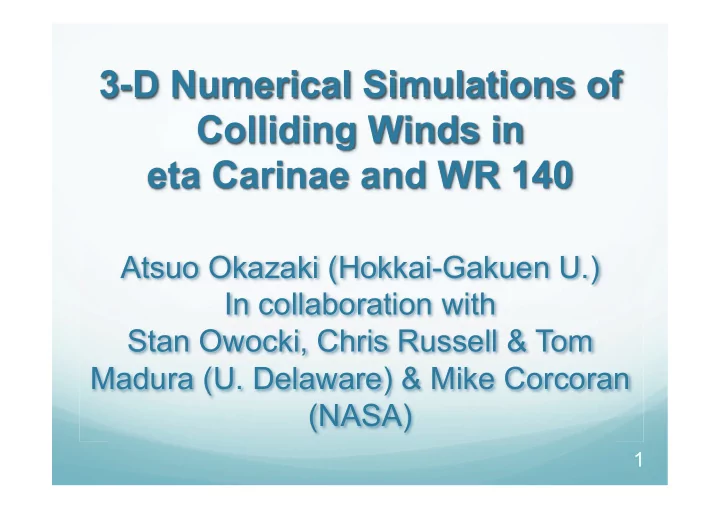

Atsuo Okazaki (Hokkai-Gakuen U.) In collaboration with Stan Owocki, Chris Russell & Tom Madura (U. Delaware) & Mike Corcoran (NASA) 1
Introduction Massive stars have strong winds driven by strong line radiation Winds collide in binaries with OB stars Luminous Blue Variables (LBV) Wolf-Rayet stars Wind-wind collision also occurs in binaries consisting of a massive star and a pulsar with a pulsar wind 2
Colliding wind binaries show interesting orbital modulations in various wave bands. It’s hard to interpret these modulations without detailed 3-D modeling of wind-wind collision when binaries are highly eccentric as in the case of eta Car and WR 140 (and the gamma-ray binary B1259-63). � 3
observed features � of eta Car, WR140, … comparison this work 3-D dynamical model + emission model Understanding of physics of wind-wind collision and nature of these systems � 4
Numerical model • 3-D SPH code (Bate et al. 1995) with the standard artificial viscosity: alpha(SPH)=1, beta(SPH)=2 • Winds are isothermal or adiabatic: No radiative cooling is taken into account. • Winds coast without net external forces, effectively assuming that gravity is canceled by radiative driving terms. 5
eta Carinae 6
Stellar, wind & binary parameters eta Car A eta Car B M ( Msun ) � 90 30 R ( Rsun ) � 90 30 Mdot ( Msun/yr ) � 2.5x10^{-4} � 10^{-5} � V wind (km/s) � 3,000 500 T wind (K) � 35,000 (isothermal) P orb (yr) � 5.54 e � 0.9 Wind momentum ratio=4.2 � 7
Results from Okazaki et al. (2008) • Low-density, fast wind from the secondary carves out high-density, slow wind from the primary • Because of high eccentricity, the cavity is very thin on the periastron side, while it occupies a large volume on the apastron side 8
Simulation within r =10a (~0.07 arcsec) ~300 au Density on the Density on the orbital plane axis plane 9
Simulation within r =100a (~0.7 arcsec) (see also Gull et al. 2009) � ~3000 au Density on the Density on the orbital plane axis plane 10
3-D structure of the winds in eta Car Large cavities of similar shape separated by thin, primary wind region are present on the apastron side ~3000 AU 11
WR 140 12
WR 140 • A WR binary: WC7 + O4-5V • Transient dust formation at periastron • Radial velocities, IR and X-ray lightcurves vary with 7.9 yr periodicity • Deep X-ray minimum at periastron, similar to that of eta Car 13
Stellar, wind & binary parameters O4-5V WC7 M ( Msun ) � 50 19 R ( Rsun ) � 12 13 Mdot ( Msun/yr ) � 1.2x10^{-6} � 3.8x10^{-5} � 2,860 V wind (km/s) � 3,200 T wind (K) � 42,000 (initially) P orb (yr) � 7.94 e � 0.881 Wind momentum ratio=0.038 � 14
RXTE X-ray light curve of WR 140 (2001-2009) http://asd.gsfc.nasa.gov/Michael.Corcoran/ wr140/wr140_rxte_lightcurves/index.html 15
Adiabatic simulation within r = 100a 16
Comparison of wind structure WR 140 eta Car 17
Summary • 3-D SPH simulations of colliding winds show how low density wind carves out high density wind: In high e systems like eta Car and WR 140, cavity is thin on periastron side, whereas it occupies a large volume on apastron side. • Because of its higher wind mom. ratio and lower speed of the slower wind, eta Car has wider interaction cone and more-tightly wound spiral structure. 18
Recommend
More recommend